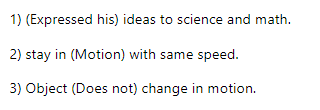Born January 4, 1643 in England As a young student, Newton didn't do well in school. He worked hard and continued his education. Later in life, Newton ideas to science and math. ton's Law of Inertia "An object at rest, tends to stay at rest, and an object in motion, tends stay in acted upon an outside force." Objects The more mass an object has, the greater its with the same speed and in the same direction, unless change in motion. wton's Law of Force and Acceleration F = m a on object of object x %3D
Born January 4, 1643 in England As a young student, Newton didn't do well in school. He worked hard and continued his education. Later in life, Newton ideas to science and math. ton's Law of Inertia "An object at rest, tends to stay at rest, and an object in motion, tends stay in acted upon an outside force." Objects The more mass an object has, the greater its with the same speed and in the same direction, unless change in motion. wton's Law of Force and Acceleration F = m a on object of object x %3D
College Physics
11th Edition
ISBN:9781305952300
Author:Raymond A. Serway, Chris Vuille
Publisher:Raymond A. Serway, Chris Vuille
Chapter1: Units, Trigonometry. And Vectors
Section: Chapter Questions
Problem 1CQ: Estimate the order of magnitude of the length, in meters, of each of the following; (a) a mouse, (b)...
Related questions
Topic Video
Question

Transcribed Image Text:Newton's Laws of M.
saac Newton
Born January 4, 1643 in England
As a young student, Newton didn't do well in school.
He worked hard and continued his education.
Later in life, Newton
ideas to science and math.
ton's Law of Inertia
An object at rest, tends to stay at rest, and an object in motion, tends r
stay in
acted
with the same speed and in the same direction, unless
upon an outside force."
Objects
IThe more mass an object has, the greater its
change in motion.
ewton's Law of Force and Acceleration
F = m a
on object =
of object x
%3D
For example..
If the force remains constant,
will have greater
acceleration compared to larger masses.
States)
wwwTT w
OFocus
FEB
13
tv
Expert Solution
Step 1

Trending now
This is a popular solution!
Step by step
Solved in 2 steps with 2 images

Knowledge Booster
Learn more about
Need a deep-dive on the concept behind this application? Look no further. Learn more about this topic, physics and related others by exploring similar questions and additional content below.Recommended textbooks for you

College Physics
Physics
ISBN:
9781305952300
Author:
Raymond A. Serway, Chris Vuille
Publisher:
Cengage Learning

University Physics (14th Edition)
Physics
ISBN:
9780133969290
Author:
Hugh D. Young, Roger A. Freedman
Publisher:
PEARSON

Introduction To Quantum Mechanics
Physics
ISBN:
9781107189638
Author:
Griffiths, David J., Schroeter, Darrell F.
Publisher:
Cambridge University Press

College Physics
Physics
ISBN:
9781305952300
Author:
Raymond A. Serway, Chris Vuille
Publisher:
Cengage Learning

University Physics (14th Edition)
Physics
ISBN:
9780133969290
Author:
Hugh D. Young, Roger A. Freedman
Publisher:
PEARSON

Introduction To Quantum Mechanics
Physics
ISBN:
9781107189638
Author:
Griffiths, David J., Schroeter, Darrell F.
Publisher:
Cambridge University Press

Physics for Scientists and Engineers
Physics
ISBN:
9781337553278
Author:
Raymond A. Serway, John W. Jewett
Publisher:
Cengage Learning

Lecture- Tutorials for Introductory Astronomy
Physics
ISBN:
9780321820464
Author:
Edward E. Prather, Tim P. Slater, Jeff P. Adams, Gina Brissenden
Publisher:
Addison-Wesley

College Physics: A Strategic Approach (4th Editio…
Physics
ISBN:
9780134609034
Author:
Randall D. Knight (Professor Emeritus), Brian Jones, Stuart Field
Publisher:
PEARSON